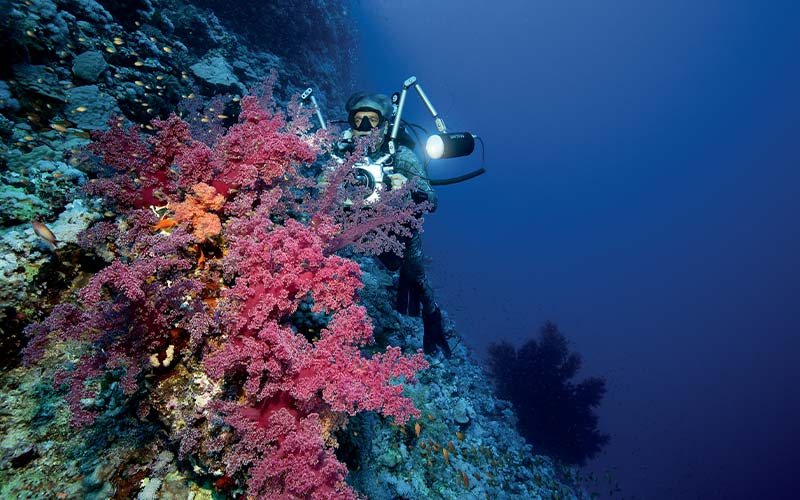The Red Sea is a vast body of water that flows into the Indian Ocean. It’s rimmed by the arid lands of Egypt and the Sudan to the west and Saudi Arabia to the east. Most Red Sea dive tourism is to the Egyptian Red Sea, traditionally via Sharm el Sheikh and Hurghada. In the past decade a new portal to the Southern Red Sea has evolved at Marsa Alam. Via direct flight to nearby Marsa Alam or three-hour bus ride from the Hurghada airport, the marina at Port Ghalib has become a convenient gateway to the extraordinary dive options of the Southern Red Sea. The images in this photo diary are all from a 10-day liveaboard safari in July 2015.







Because the Red Sea is essentially an oasis of marine beauty in the midst of a desert, there is very little fresh water to degrade visibility. The stark contrast between the azure depths, punctuated with soft corals of every imaginable pastel hue, and the tan sand and hills above are one of the wonders of the world of diving. With 1,200 species of fish, 10 percent of which are endemic to the region, the Red Sea is remarkably fertile for underwater photography. While macro subjects abound, I have always found it difficult to take my eye away from the fish portraits and wide-angle vistas the Red Sea presents.




No one seems to know for sure how the Red Sea got its name. Had the ancient Egyptians who first explored the area in 2500 B.C. donned scuba gear and peered beneath the surface, the appellation could have been for the brilliant soft corals, the large schools of bigeye along the walls at Little Brother Island or the mantles of the anemones decorating the shallows at Daedalus Reef.
How To Dive It

Getting There
Both Hurghada and Sharm el Sheikh are popular fun-in-the-sun vacation destinations for Europeans, and there are modern international airports at both cities. It is easy to connect via Cairo or major European gateways. There are also direct commercial and charter flights to Marsa Alam from Cairo and Europe, but flights are less frequent than those to Hurghada. It is a three-hour bus ride from Hurghada to Port Ghalib. Be sure to arrive on time for your liveaboard departure because security regulations prohibit boats from returning to port to pick up tardy passengers or delayed baggage.
Conditions
The difference between winter and summer conditions is dramatic. In the winter the water may cool down to 72°F while it may be as warm as 84°F in the summer. Winter winds typically pick up as well, making some of the crossings to the offshore islands more difficult. Some sites are easy dives, while the effects of currents can complicate others. Most dives are multilevel, offering the possibility to work up a wall or a pinnacle to offgass. Dive operators in the Red Sea tend to enforce the buddy system, and divers should be adept at deploying a surface marker buoy. There are modern hyperbaric chamber facilities in Hurghada, Sharm el-Sheikh and elsewhere in Egypt, as well as in Israel, Jordan and Saudi Arabia.
© Alert Diver — Q4 Fall 2015